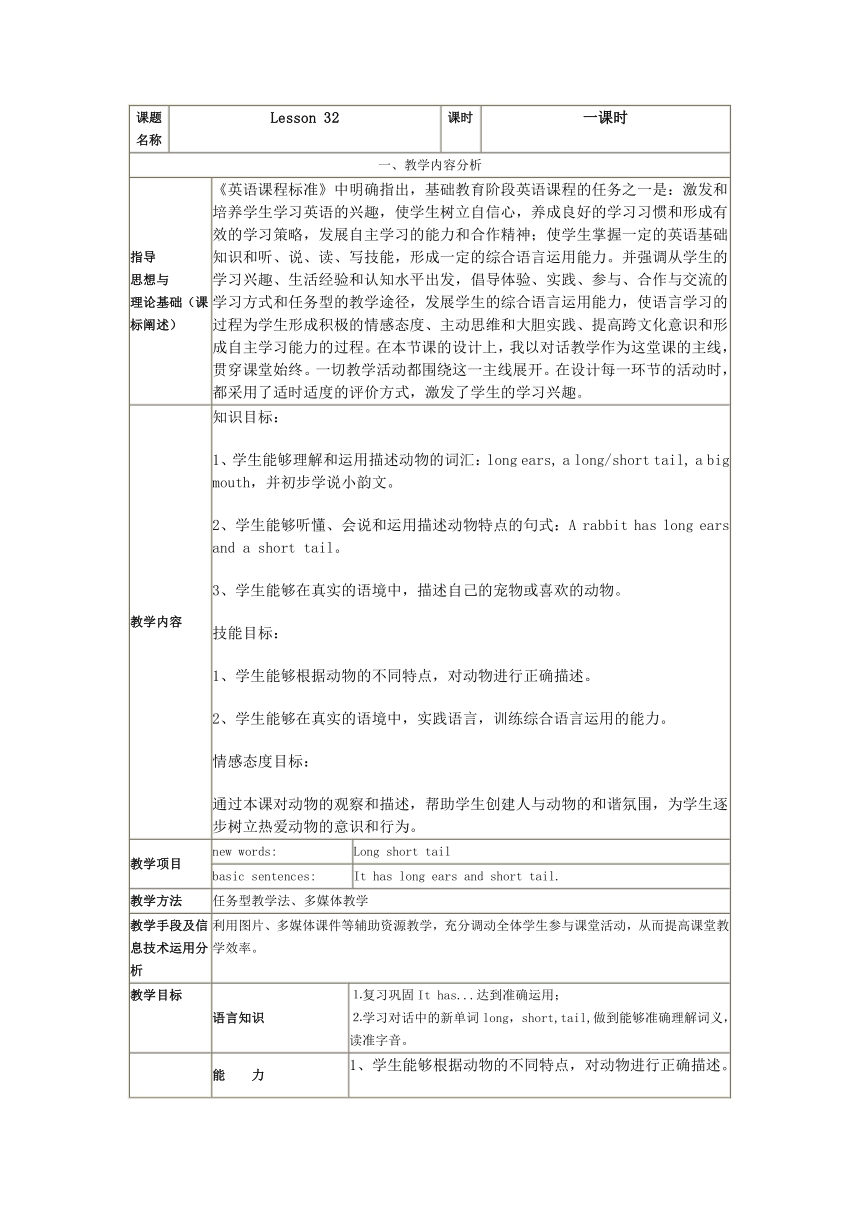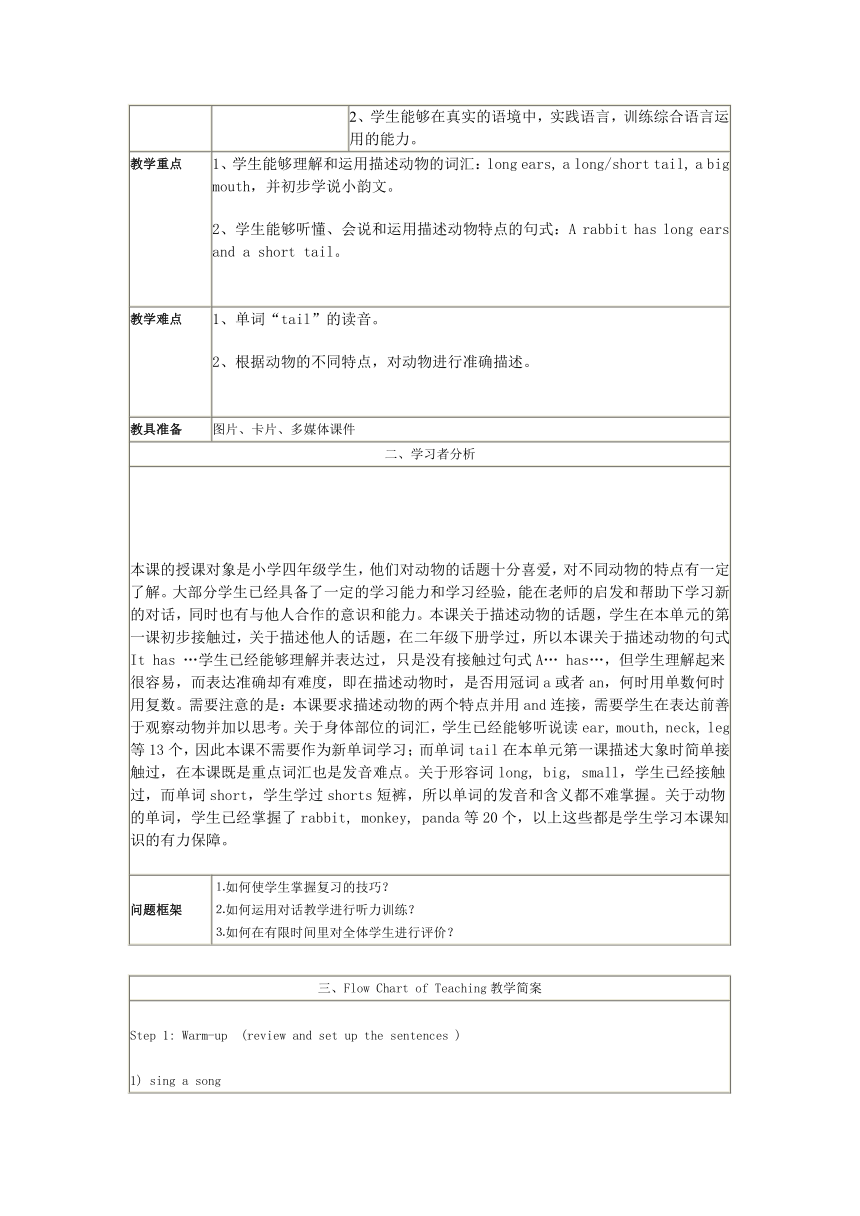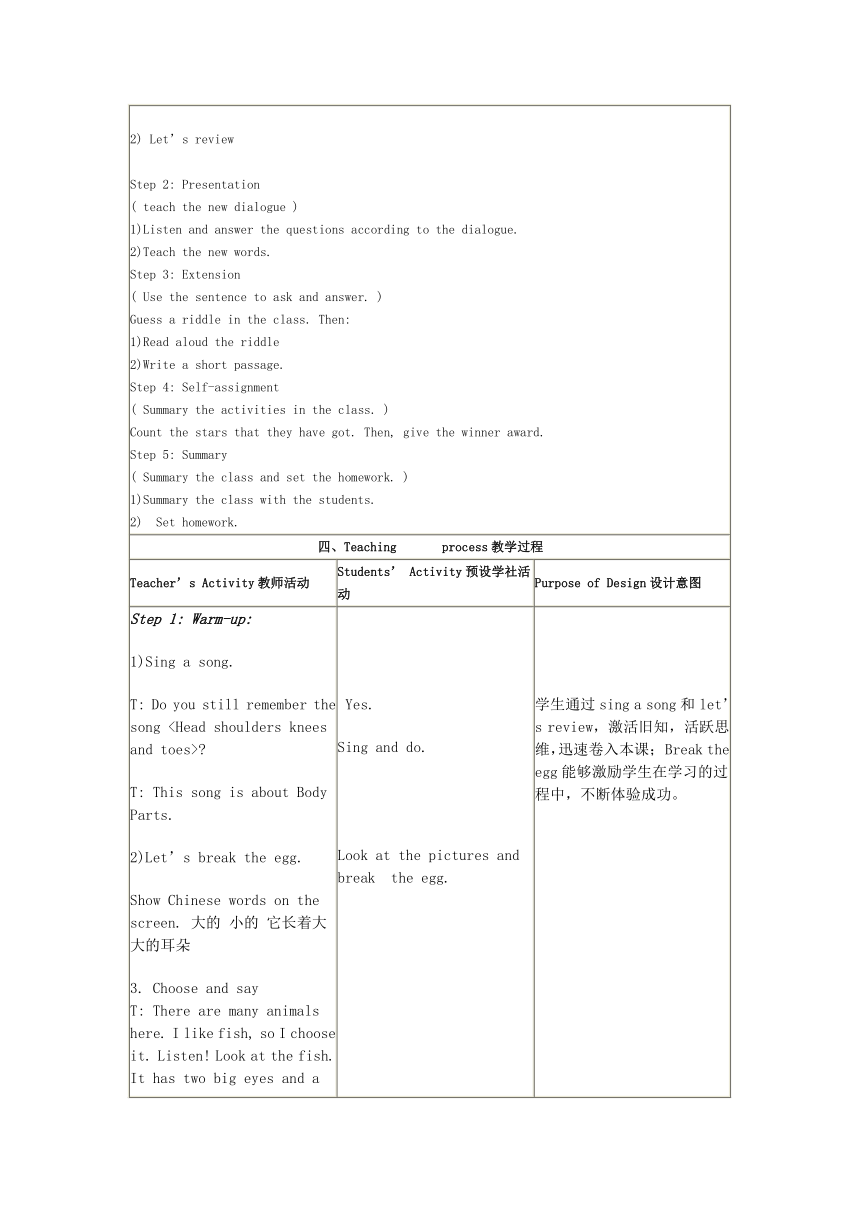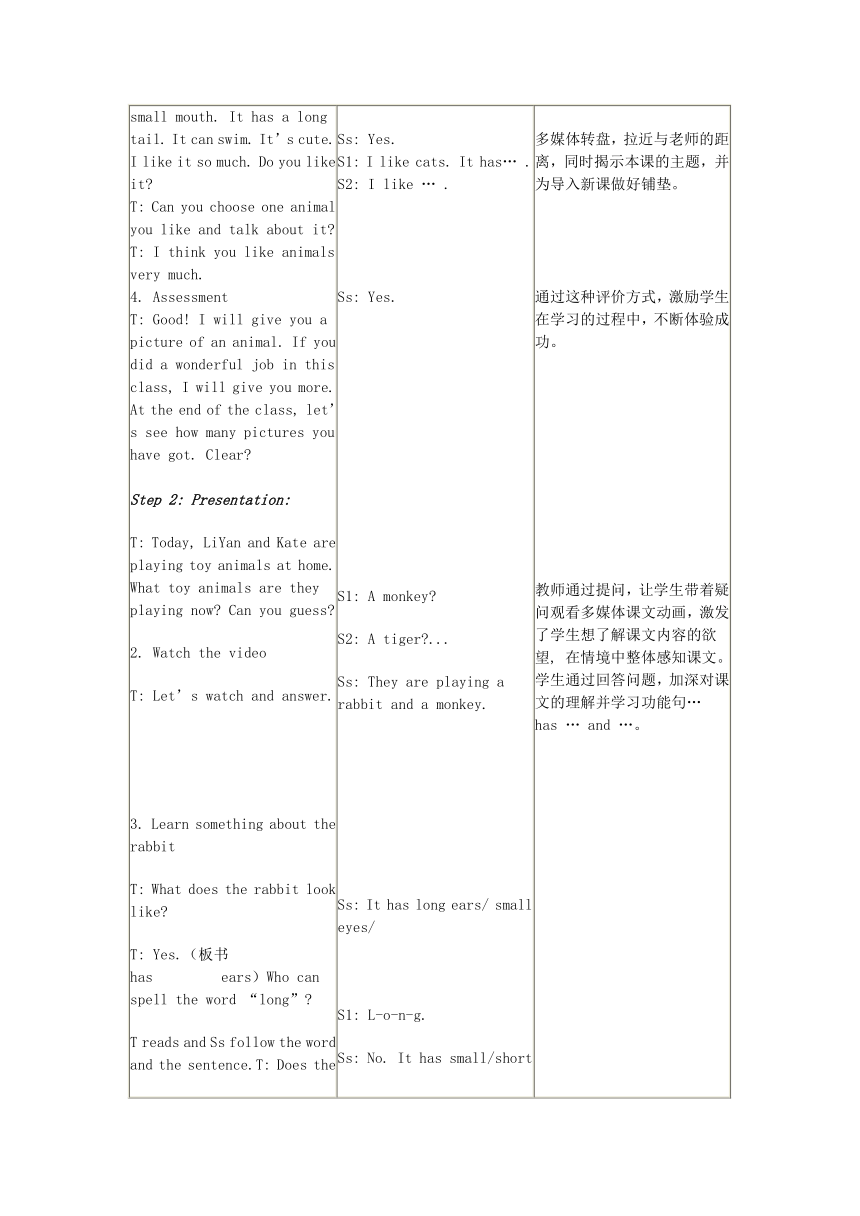Unit6 I'm tall Lesson 32 表格式教案(含反思)
文档属性
| 名称 | Unit6 I'm tall Lesson 32 表格式教案(含反思) |

|
|
| 格式 | doc | ||
| 文件大小 | 94.5KB | ||
| 资源类型 | 教案 | ||
| 版本资源 | 人教精通版(三年级起点) | ||
| 科目 | 英语 | ||
| 更新时间 | 2020-10-27 09:03:39 | ||
图片预览




文档简介
课题名称 Lesson 32 课时 一课时
一、教学内容分析
指导 思想与
理论基础(课标阐述) 《英语课程标准》中明确指出,基础教育阶段英语课程的任务之一是:激发和培养学生学习英语的兴趣,使学生树立自信心,养成良好的学习习惯和形成有效的学习策略,发展自主学习的能力和合作精神;使学生掌握一定的英语基础知识和听、说、读、写技能,形成一定的综合语言运用能力。并强调从学生的学习兴趣、生活经验和认知水平出发,倡导体验、实践、参与、合作与交流的学习方式和任务型的教学途径,发展学生的综合语言运用能力,使语言学习的过程为学生形成积极的情感态度、主动思维和大胆实践、提高跨文化意识和形成自主学习能力的过程。在本节课的设计上,我以对话教学作为这堂课的主线,贯穿课堂始终。一切教学活动都围绕这一主线展开。在设计每一环节的活动时,都采用了适时适度的评价方式,激发了学生的学习兴趣。
教学内容 知识目标:
1、学生能够理解和运用描述动物的词汇:long ears, a long/short tail, a big mouth,并初步学说小韵文。
2、学生能够听懂、会说和运用描述动物特点的句式:A rabbit has long ears and a short tail。
3、学生能够在真实的语境中,描述自己的宠物或喜欢的动物。
技能目标:
1、学生能够根据动物的不同特点,对动物进行正确描述。
2、学生能够在真实的语境中,实践语言,训练综合语言运用的能力。
情感态度目标:
通过本课对动物的观察和描述,帮助学生创建人与动物的和谐氛围,为学生逐步树立热爱动物的意识和行为。
教学项目 new words: Long short tail
basic sentences: It has long ears and short tail.
教学方法 任务型教学法、多媒体教学
教学手段及信息技术运用分析 利用图片、多媒体课件等辅助资源教学,充分调动全体学生参与课堂活动,从而提高课堂教学效率。
教学目标 语言知识 ⒈复习巩固It has...达到准确运用;
⒉学习对话中的新单词long,short,tail,做到能够准确理解词义,读准字音。
? 能??力 1、学生能够根据动物的不同特点,对动物进行正确描述。
2、学生能够在真实的语境中,实践语言,训练综合语言运用的能力。
教学重点 1、学生能够理解和运用描述动物的词汇:long ears, a long/short tail, a big mouth,并初步学说小韵文。
2、学生能够听懂、会说和运用描述动物特点的句式:A rabbit has long ears and a short tail。
教学难点 1、单词“tail”的读音。
2、根据动物的不同特点,对动物进行准确描述。
教具准备 图片、卡片、多媒体课件
二、学习者分析
本课的授课对象是小学四年级学生,他们对动物的话题十分喜爱,对不同动物的特点有一定了解。大部分学生已经具备了一定的学习能力和学习经验,能在老师的启发和帮助下学习新的对话,同时也有与他人合作的意识和能力。本课关于描述动物的话题,学生在本单元的第一课初步接触过,关于描述他人的话题,在二年级下册学过,所以本课关于描述动物的句式It has …学生已经能够理解并表达过,只是没有接触过句式A… has…,但学生理解起来很容易,而表达准确却有难度,即在描述动物时,是否用冠词a或者an,何时用单数何时用复数。需要注意的是:本课要求描述动物的两个特点并用and连接,需要学生在表达前善于观察动物并加以思考。关于身体部位的词汇,学生已经能够听说读ear, mouth, neck, leg等13个,因此本课不需要作为新单词学习;而单词tail在本单元第一课描述大象时简单接触过,在本课既是重点词汇也是发音难点。关于形容词long, big, small,学生已经接触过,而单词short,学生学过shorts短裤,所以单词的发音和含义都不难掌握。关于动物的单词,学生已经掌握了rabbit, monkey, panda等20个,以上这些都是学生学习本课知识的有力保障。
问题框架 ⒈如何使学生掌握复习的技巧?
⒉如何运用对话教学进行听力训练?
⒊如何在有限时间里对全体学生进行评价?
?
三、Flow Chart of Teaching教学简案
?
Step 1: Warm-up?(review and set up the sentences )?
?
1) sing a song
?
2) Let’s review
?
Step 2: Presentation
( teach the new dialogue )
1)Listen and answer the questions according to the dialogue.
2)Teach the new words.
Step 3: Extension
( Use the sentence to ask and answer. )
Guess a riddle in the class. Then:
1)Read aloud the riddle
2)Write a short passage.
Step 4: Self-assignment
( Summary the activities in the class. )
Count the stars that they have got. Then, give the winner award.
Step 5: Summary
( Summary the class and set the homework. )
1)Summary the class with the students.
2)燬et homework.
四、Teaching?? ?process教学过程
Teacher’s Activity教师活动 Students’ Activity预设学社活动 Purpose of Design设计意图
Step 1: Warm-up: 1)Sing a song.
T: Do you still remember the song ?
T: This song is about Body Parts.
Let’s break the egg.
Show Chinese words on the screen. 大的 小的 它长着大大的耳朵
Choose and say
T: There are many animals here. I like fish, so I choose it. Listen! Look at the fish. It has two big eyes and a small mouth. It has a long tail. It can swim. It’s cute. I like it so much. Do you like it?
T: Can you choose one animal you like and talk about it?
T: I think you like animals very much.
Assessment
T: Good! I will give you a picture of an animal. If you did a wonderful job in this class, I will give you more. At the end of the class, let抯 see how many pictures you have got. Clear?
Step 2: Presentation:
T: Today, LiYan and Kate are playing toy animals at home. What toy animals are they playing now? Can you guess?
2. Watch the video
T: Let抯 watch and answer.
3. Learn something about the rabbit
T: What does the rabbit look like?
T: Yes.(板书has???? ears)Who can spell the word “long”?
T reads and Ss follow the word and the sentence.T: Does the monkey have long ears?
T: Who has long ears, too?
T: Do you have long ears?
T: A rabbit has long ears and .
T: ai sounds like / ei / , / teil /
T: Is it a long tail?
T:many animals have own tail,look,who has a tail?
T:They lost their body part,can you help them?
Next, have them read the books in groups. Then, have some groups act out.
Give them some stars.
Summary the dialogue.
Read in pairs: LiYan and Kate.
Yes.
Sing and do.
Look at the pictures and break the egg.
Ss: Yes.
S1: I like cats. It has .
S2: I like .
Ss: Yes.
S1: A monkey?
S2: A tiger?...
Ss: They are playing a rabbit and a monkey.
Ss: It has long ears/ small eyes/
S1: L-o-n-g.
Ss: No. It has small/short ears.
S1:The elephant has long ears.
S2:dog/kangaroo has long ears.
No. I have short/small ears.
Ss: a short tail.
Ss: Listen and repeat.
Ss: No, it抯 a short tail.
a kangroo, a sheep and a peacock.
S1:The panda has a short tail.
S2:The elephant has a long nose.
S3:The squirrel has a big tail.
Listen to the tape and read the dialogue.
S1 read LiYan,S2 read Kate.
?
学生通过sing a song和let’s review,激活旧知,活跃思维,迅速卷入本课; Break the egg能够激励学生在学习的过程中,不断体验成功。
?
?
?
?
?
?
?
?
多媒体转盘,拉近与老师的距离,同时揭示本课的主题,并为导入新课做好铺垫。
?
?
?
?
通过这种评价方式,激励学生在学习的过程中,不断体验成功。
教师通过提问,让学生带着疑问观看多媒体课文动画,激发了学生想了解课文内容的欲望, 在情境中整体感知课文。学生通过回答问题,加深对课文的理解并学习功能句… has … and …。
提出问题,引发学生对自己能力的思考。
通过介绍,使学生感悟词义。
?
利用多媒体遮挡图片,设计简单问题,使学生参与课堂活动。
学生通过多媒体flash跟读,帮助学生内化了课文中的语言。
T:Look at the girl,she wants to talk something,let’s listen.
T:Who’s he?
let’s listen.
T:There are many different things on the screen.
T: LiYan and Kate can describe the animals. Can you say something about this elephant/cat?
Display the cartoons of the rhyme.
T: Can you make a new chant?
Then, the teacher read a lot of Opposite words.
in out
empty full
fast slow
soft hard
T:let抯 play a game.
Guess a riddle.
T:Write a riddle.
Then, have them use these words ask and answer in groups.
T:today,we talked so much about animals,in our daily life,many people have their own pet or animal toys.
Do you have a pet?
Watch a video.
T::There are so many animals in the world.Some are big.Some are small.My favorite animal is panda.
T:?I like panda.Look at the panda. It has big eyes and small nose.It has round ears.It likes bamboo.It lives(居住) in China.
T:I like your pets and your favorite animals.you love pets so much.Because animals are our good friends, we should protect the animals.
Step 3: Self-assignment:
Collect the stars. Put them on the blackboard. Ask each group:
How many stars can you get?
Then, give the winner the award.
( pictures of animals)
step 6: Summary:
Have them look at the blackboard and read aloud.
Set homework:
1) Introduce animals to your friends.
2) Practice in pairs
. Look and listen to the radio.
?
?
It’s me.
S1:The watermelon is big.
The lemon is small.
S2:The giraffe is long..
The dog is short.
Say the chant with the music.
Let me try. A … has a… and … . A … has … and ….
young old
S1:?It?has?red?eyes?and?short?tail.
S2:?It?has?spot?on?his?body.
S3:It?has?long?neck.
Listen to the riddle and answer to it.
Look at the PPT
Students and their own pets
Look at the picture of the dialogue. Listen to the teacher’s introduction
someone read.
Some groups read in role.
Give the stars to the teacher. Count the stars. Write the number on the picture.
Look at the blackboard and read aloud.
Remember the homework..
观看学生自制视频,观察和谈论视频,同时开动脑筋思考问题,培养学生的思维能力。
播放视频,再一次强调反义词,既为学生练习提供材料,又能强调形容词的用法。
?
多媒体提供大量素材,加深反义词的记忆理解。
利用师大版教材相关内容,既做到教材的整合,动画的播放,再一次调动学生的学习兴趣,加深对It has句型应用的理解。
?
安排小组间合作练习,每个小组成员间不能出现相同的句子。既体现了小组间的合作,又使练习的安排具有一定难度。
?
多媒体出示大量反义词,在这个过程中,老师有目的地提高他们综合运用语言的能力。
?
多媒体增强学生合作能力,让学生用所学动物练习对话,让学生感受到英语学习就在我们身边。可以让每个学生都参与进来,在练习中发现问题并及时解决,可以让每个学生都能掌握所学句型,巩固所学也把本课的教学推向了高潮。
对所学知识及时总结,总结句型的同时,使用了新词汇,加深学生对词汇的理解和运用。
?
大屏幕播放学生和小动物之间照片,增强了学生的自豪感。同时,让学生结合自己对小动物们的认识,按真实情况回答问题。
学生根据自己的实际情况,书写重点词汇,运用语言。在这个过程中,老师有目的地提高他们综合运用语言的能力。
?
师生互动,总结本节课所学知识
集体观看评价结果,表彰获胜组,对其他组也是一个激励。
?
Blackboard Designing(板书)
Lesson 32 A rabbit has long ears and short tail.?
评价方式 本节课我采用了多种评价方式,激发学生的学习兴趣,有效地提高了课堂效率。
⒈口头表扬。当学生表现出色,老师会给予及时的表扬,如:Very good!excellent! Well done! 等等,当学生克服困难,再次表现出色时,老师也适时地给予鼓励和表扬。
⒉物质激励。在学生个人回答问题出色时,教师及时地利用手中的sticker进行评价,有效地调动学生的表现欲望,营造了浓厚的学习氛围。
⒊小组评价。为了开展好小组评价,在上课前我把全班分成了男孩、女孩组,在课堂教学中,及时全面地记录小组成员的表现情况,最后根据评比结果表扬获胜组,激励全班同学。
教学设计说明
在设计本课教案时,我主要体现了以下几个特点:
一、安排设计任务,体现小组合作。
在课堂活动中,我还注意培养学生的合作意识,通过小组成员间的相互配合来完成一些练习,在本课的 It has练习中,我设计了让小组成员间进行问答的内容,在学生练习前,我明确告诉他们不能造出相同的句子,这就使练习增加了难度,同时又锻炼了他们小组间的合作意识。
在本节课的教学过程中,评价贯穿了课堂始终,起到了组织课堂教学,激发学生学习兴趣的作用。
⒈口头表扬。当学生表现出色,老师会给予及时的表扬,如:Very good!excellent! Well done! 等等,当学生克服困难,再次表现出色时,老师也适时地给予鼓励和表扬。
⒉物质激励。在学生个人回答问题出色时,教师及时地利用手中的sticker进行评价,有效地调动学生的表现欲望,营造了浓厚的学习氛围。在课堂教学中,及时全面地记录小组成员的表现情况,最后根据评比结果表扬获胜组,激励全班同学。
反思:
1、加强四会单词的听说读写,平时上课时注意复习滚动已学单词,经常听写,要求学生多抄多读多背。
2、加强四会句子的书写教授。句子正确书写形式应该开头字母大写,句末有标点,单词之间有间隔。这些要求在平时新授时应该特别强调,让学生跟着写一写,课后再布置作业去抄一抄,背一背,平时碰到句子就应时时强调。久而久之,坚持不懈,让学生形成一种习惯,既使到了六年级就要强调句子的正确书写格式。
3、重点单词在平时应该强调应用,重点对话在平时强调多操练,以不同的组织形式进行对话操练,例如师生,生生,男女,小组与小组。在重点单词巩固的基础上操练理解句子,在句子的操练中理解应用单词。
4、加强教材中的Let's talk的读和说。在平时应该鼓励学生多读,对程度好的学生应该鼓励多背。可开展朗读能手竞赛,必读课文,必背课文等形式进行鼓励性与强制性记忆结合的措施,让学生熟悉教材上的内容。在此基础上再进行仿演对话,改编对话练习,以达到学以致用的目的。
5、加强对教材中的chant的练唱。在课前3分钟可安排chant的滚动复习和操练。chant虽不作用教学重点,但不能抛弃不学。
当然,在教学过程中,也还存在着一些不足。希望大家提出宝贵意见,使我的教育教学能力得以提高。
一、教学内容分析
指导 思想与
理论基础(课标阐述) 《英语课程标准》中明确指出,基础教育阶段英语课程的任务之一是:激发和培养学生学习英语的兴趣,使学生树立自信心,养成良好的学习习惯和形成有效的学习策略,发展自主学习的能力和合作精神;使学生掌握一定的英语基础知识和听、说、读、写技能,形成一定的综合语言运用能力。并强调从学生的学习兴趣、生活经验和认知水平出发,倡导体验、实践、参与、合作与交流的学习方式和任务型的教学途径,发展学生的综合语言运用能力,使语言学习的过程为学生形成积极的情感态度、主动思维和大胆实践、提高跨文化意识和形成自主学习能力的过程。在本节课的设计上,我以对话教学作为这堂课的主线,贯穿课堂始终。一切教学活动都围绕这一主线展开。在设计每一环节的活动时,都采用了适时适度的评价方式,激发了学生的学习兴趣。
教学内容 知识目标:
1、学生能够理解和运用描述动物的词汇:long ears, a long/short tail, a big mouth,并初步学说小韵文。
2、学生能够听懂、会说和运用描述动物特点的句式:A rabbit has long ears and a short tail。
3、学生能够在真实的语境中,描述自己的宠物或喜欢的动物。
技能目标:
1、学生能够根据动物的不同特点,对动物进行正确描述。
2、学生能够在真实的语境中,实践语言,训练综合语言运用的能力。
情感态度目标:
通过本课对动物的观察和描述,帮助学生创建人与动物的和谐氛围,为学生逐步树立热爱动物的意识和行为。
教学项目 new words: Long short tail
basic sentences: It has long ears and short tail.
教学方法 任务型教学法、多媒体教学
教学手段及信息技术运用分析 利用图片、多媒体课件等辅助资源教学,充分调动全体学生参与课堂活动,从而提高课堂教学效率。
教学目标 语言知识 ⒈复习巩固It has...达到准确运用;
⒉学习对话中的新单词long,short,tail,做到能够准确理解词义,读准字音。
? 能??力 1、学生能够根据动物的不同特点,对动物进行正确描述。
2、学生能够在真实的语境中,实践语言,训练综合语言运用的能力。
教学重点 1、学生能够理解和运用描述动物的词汇:long ears, a long/short tail, a big mouth,并初步学说小韵文。
2、学生能够听懂、会说和运用描述动物特点的句式:A rabbit has long ears and a short tail。
教学难点 1、单词“tail”的读音。
2、根据动物的不同特点,对动物进行准确描述。
教具准备 图片、卡片、多媒体课件
二、学习者分析
本课的授课对象是小学四年级学生,他们对动物的话题十分喜爱,对不同动物的特点有一定了解。大部分学生已经具备了一定的学习能力和学习经验,能在老师的启发和帮助下学习新的对话,同时也有与他人合作的意识和能力。本课关于描述动物的话题,学生在本单元的第一课初步接触过,关于描述他人的话题,在二年级下册学过,所以本课关于描述动物的句式It has …学生已经能够理解并表达过,只是没有接触过句式A… has…,但学生理解起来很容易,而表达准确却有难度,即在描述动物时,是否用冠词a或者an,何时用单数何时用复数。需要注意的是:本课要求描述动物的两个特点并用and连接,需要学生在表达前善于观察动物并加以思考。关于身体部位的词汇,学生已经能够听说读ear, mouth, neck, leg等13个,因此本课不需要作为新单词学习;而单词tail在本单元第一课描述大象时简单接触过,在本课既是重点词汇也是发音难点。关于形容词long, big, small,学生已经接触过,而单词short,学生学过shorts短裤,所以单词的发音和含义都不难掌握。关于动物的单词,学生已经掌握了rabbit, monkey, panda等20个,以上这些都是学生学习本课知识的有力保障。
问题框架 ⒈如何使学生掌握复习的技巧?
⒉如何运用对话教学进行听力训练?
⒊如何在有限时间里对全体学生进行评价?
?
三、Flow Chart of Teaching教学简案
?
Step 1: Warm-up?(review and set up the sentences )?
?
1) sing a song
?
2) Let’s review
?
Step 2: Presentation
( teach the new dialogue )
1)Listen and answer the questions according to the dialogue.
2)Teach the new words.
Step 3: Extension
( Use the sentence to ask and answer. )
Guess a riddle in the class. Then:
1)Read aloud the riddle
2)Write a short passage.
Step 4: Self-assignment
( Summary the activities in the class. )
Count the stars that they have got. Then, give the winner award.
Step 5: Summary
( Summary the class and set the homework. )
1)Summary the class with the students.
2)燬et homework.
四、Teaching?? ?process教学过程
Teacher’s Activity教师活动 Students’ Activity预设学社活动 Purpose of Design设计意图
Step 1: Warm-up: 1)Sing a song.
T: Do you still remember the song ?
T: This song is about Body Parts.
Let’s break the egg.
Show Chinese words on the screen. 大的 小的 它长着大大的耳朵
Choose and say
T: There are many animals here. I like fish, so I choose it. Listen! Look at the fish. It has two big eyes and a small mouth. It has a long tail. It can swim. It’s cute. I like it so much. Do you like it?
T: Can you choose one animal you like and talk about it?
T: I think you like animals very much.
Assessment
T: Good! I will give you a picture of an animal. If you did a wonderful job in this class, I will give you more. At the end of the class, let抯 see how many pictures you have got. Clear?
Step 2: Presentation:
T: Today, LiYan and Kate are playing toy animals at home. What toy animals are they playing now? Can you guess?
2. Watch the video
T: Let抯 watch and answer.
3. Learn something about the rabbit
T: What does the rabbit look like?
T: Yes.(板书has???? ears)Who can spell the word “long”?
T reads and Ss follow the word and the sentence.T: Does the monkey have long ears?
T: Who has long ears, too?
T: Do you have long ears?
T: A rabbit has long ears and .
T: ai sounds like / ei / , / teil /
T: Is it a long tail?
T:many animals have own tail,look,who has a tail?
T:They lost their body part,can you help them?
Next, have them read the books in groups. Then, have some groups act out.
Give them some stars.
Summary the dialogue.
Read in pairs: LiYan and Kate.
Yes.
Sing and do.
Look at the pictures and break the egg.
Ss: Yes.
S1: I like cats. It has .
S2: I like .
Ss: Yes.
S1: A monkey?
S2: A tiger?...
Ss: They are playing a rabbit and a monkey.
Ss: It has long ears/ small eyes/
S1: L-o-n-g.
Ss: No. It has small/short ears.
S1:The elephant has long ears.
S2:dog/kangaroo has long ears.
No. I have short/small ears.
Ss: a short tail.
Ss: Listen and repeat.
Ss: No, it抯 a short tail.
a kangroo, a sheep and a peacock.
S1:The panda has a short tail.
S2:The elephant has a long nose.
S3:The squirrel has a big tail.
Listen to the tape and read the dialogue.
S1 read LiYan,S2 read Kate.
?
学生通过sing a song和let’s review,激活旧知,活跃思维,迅速卷入本课; Break the egg能够激励学生在学习的过程中,不断体验成功。
?
?
?
?
?
?
?
?
多媒体转盘,拉近与老师的距离,同时揭示本课的主题,并为导入新课做好铺垫。
?
?
?
?
通过这种评价方式,激励学生在学习的过程中,不断体验成功。
教师通过提问,让学生带着疑问观看多媒体课文动画,激发了学生想了解课文内容的欲望, 在情境中整体感知课文。学生通过回答问题,加深对课文的理解并学习功能句… has … and …。
提出问题,引发学生对自己能力的思考。
通过介绍,使学生感悟词义。
?
利用多媒体遮挡图片,设计简单问题,使学生参与课堂活动。
学生通过多媒体flash跟读,帮助学生内化了课文中的语言。
T:Look at the girl,she wants to talk something,let’s listen.
T:Who’s he?
let’s listen.
T:There are many different things on the screen.
T: LiYan and Kate can describe the animals. Can you say something about this elephant/cat?
Display the cartoons of the rhyme.
T: Can you make a new chant?
Then, the teacher read a lot of Opposite words.
in out
empty full
fast slow
soft hard
T:let抯 play a game.
Guess a riddle.
T:Write a riddle.
Then, have them use these words ask and answer in groups.
T:today,we talked so much about animals,in our daily life,many people have their own pet or animal toys.
Do you have a pet?
Watch a video.
T::There are so many animals in the world.Some are big.Some are small.My favorite animal is panda.
T:?I like panda.Look at the panda. It has big eyes and small nose.It has round ears.It likes bamboo.It lives(居住) in China.
T:I like your pets and your favorite animals.you love pets so much.Because animals are our good friends, we should protect the animals.
Step 3: Self-assignment:
Collect the stars. Put them on the blackboard. Ask each group:
How many stars can you get?
Then, give the winner the award.
( pictures of animals)
step 6: Summary:
Have them look at the blackboard and read aloud.
Set homework:
1) Introduce animals to your friends.
2) Practice in pairs
. Look and listen to the radio.
?
?
It’s me.
S1:The watermelon is big.
The lemon is small.
S2:The giraffe is long..
The dog is short.
Say the chant with the music.
Let me try. A … has a… and … . A … has … and ….
young old
S1:?It?has?red?eyes?and?short?tail.
S2:?It?has?spot?on?his?body.
S3:It?has?long?neck.
Listen to the riddle and answer to it.
Look at the PPT
Students and their own pets
Look at the picture of the dialogue. Listen to the teacher’s introduction
someone read.
Some groups read in role.
Give the stars to the teacher. Count the stars. Write the number on the picture.
Look at the blackboard and read aloud.
Remember the homework..
观看学生自制视频,观察和谈论视频,同时开动脑筋思考问题,培养学生的思维能力。
播放视频,再一次强调反义词,既为学生练习提供材料,又能强调形容词的用法。
?
多媒体提供大量素材,加深反义词的记忆理解。
利用师大版教材相关内容,既做到教材的整合,动画的播放,再一次调动学生的学习兴趣,加深对It has句型应用的理解。
?
安排小组间合作练习,每个小组成员间不能出现相同的句子。既体现了小组间的合作,又使练习的安排具有一定难度。
?
多媒体出示大量反义词,在这个过程中,老师有目的地提高他们综合运用语言的能力。
?
多媒体增强学生合作能力,让学生用所学动物练习对话,让学生感受到英语学习就在我们身边。可以让每个学生都参与进来,在练习中发现问题并及时解决,可以让每个学生都能掌握所学句型,巩固所学也把本课的教学推向了高潮。
对所学知识及时总结,总结句型的同时,使用了新词汇,加深学生对词汇的理解和运用。
?
大屏幕播放学生和小动物之间照片,增强了学生的自豪感。同时,让学生结合自己对小动物们的认识,按真实情况回答问题。
学生根据自己的实际情况,书写重点词汇,运用语言。在这个过程中,老师有目的地提高他们综合运用语言的能力。
?
师生互动,总结本节课所学知识
集体观看评价结果,表彰获胜组,对其他组也是一个激励。
?
Blackboard Designing(板书)
Lesson 32 A rabbit has long ears and short tail.?
评价方式 本节课我采用了多种评价方式,激发学生的学习兴趣,有效地提高了课堂效率。
⒈口头表扬。当学生表现出色,老师会给予及时的表扬,如:Very good!excellent! Well done! 等等,当学生克服困难,再次表现出色时,老师也适时地给予鼓励和表扬。
⒉物质激励。在学生个人回答问题出色时,教师及时地利用手中的sticker进行评价,有效地调动学生的表现欲望,营造了浓厚的学习氛围。
⒊小组评价。为了开展好小组评价,在上课前我把全班分成了男孩、女孩组,在课堂教学中,及时全面地记录小组成员的表现情况,最后根据评比结果表扬获胜组,激励全班同学。
教学设计说明
在设计本课教案时,我主要体现了以下几个特点:
一、安排设计任务,体现小组合作。
在课堂活动中,我还注意培养学生的合作意识,通过小组成员间的相互配合来完成一些练习,在本课的 It has练习中,我设计了让小组成员间进行问答的内容,在学生练习前,我明确告诉他们不能造出相同的句子,这就使练习增加了难度,同时又锻炼了他们小组间的合作意识。
在本节课的教学过程中,评价贯穿了课堂始终,起到了组织课堂教学,激发学生学习兴趣的作用。
⒈口头表扬。当学生表现出色,老师会给予及时的表扬,如:Very good!excellent! Well done! 等等,当学生克服困难,再次表现出色时,老师也适时地给予鼓励和表扬。
⒉物质激励。在学生个人回答问题出色时,教师及时地利用手中的sticker进行评价,有效地调动学生的表现欲望,营造了浓厚的学习氛围。在课堂教学中,及时全面地记录小组成员的表现情况,最后根据评比结果表扬获胜组,激励全班同学。
反思:
1、加强四会单词的听说读写,平时上课时注意复习滚动已学单词,经常听写,要求学生多抄多读多背。
2、加强四会句子的书写教授。句子正确书写形式应该开头字母大写,句末有标点,单词之间有间隔。这些要求在平时新授时应该特别强调,让学生跟着写一写,课后再布置作业去抄一抄,背一背,平时碰到句子就应时时强调。久而久之,坚持不懈,让学生形成一种习惯,既使到了六年级就要强调句子的正确书写格式。
3、重点单词在平时应该强调应用,重点对话在平时强调多操练,以不同的组织形式进行对话操练,例如师生,生生,男女,小组与小组。在重点单词巩固的基础上操练理解句子,在句子的操练中理解应用单词。
4、加强教材中的Let's talk的读和说。在平时应该鼓励学生多读,对程度好的学生应该鼓励多背。可开展朗读能手竞赛,必读课文,必背课文等形式进行鼓励性与强制性记忆结合的措施,让学生熟悉教材上的内容。在此基础上再进行仿演对话,改编对话练习,以达到学以致用的目的。
5、加强对教材中的chant的练唱。在课前3分钟可安排chant的滚动复习和操练。chant虽不作用教学重点,但不能抛弃不学。
当然,在教学过程中,也还存在着一些不足。希望大家提出宝贵意见,使我的教育教学能力得以提高。
同课章节目录
- Unit 1 This is my new friend.
- Lesson 1
- Lesson 2
- Lesson 3
- Lesson 4
- Lesson 5
- Lesson 6 Revision
- Unit 2 What's your number?
- Lesson 7
- Lesson 8
- Lesson 9
- Lesson 10
- Lesson 11
- Lesson 12 Revision
- Unit 3 It's a pineapple.
- Lesson 13
- Lesson 14
- Lesson 15
- Lesson 16
- Lesson 17
- Lesson 18 Revision
- Fun Time 1
- Recycle 1
- Recycle 2
- Project
- Unit 4 How's the weather today?
- Lesson 19
- Lesson 20
- Lesson 21
- Lesson 22
- Lesson 23
- Lesson 24 Revision
- Unit 5 I like those shoes.
- Lesson 25
- Lesson 26
- Lesson 27
- Lesson 28
- Lesson 29
- Lesson 30 Revision
- Unit 6 I'm tall.
- Lesson 31
- Lesson 32
- Lesson 33
- Lesson 34
- Lesson 35
- Lesson 36 Revision
- Fun Time 2
- Recycle 1
- Recycle 2
- Project
